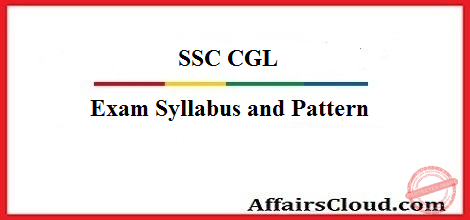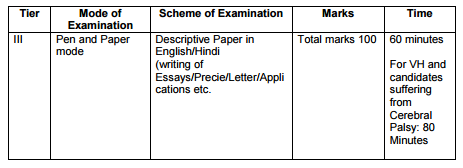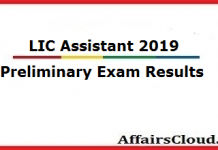Dear Aspirants,
Here we are providing you the detailed syllabus & exam pattern for the SSC Combined Graduate Level Exam(CGLE).

Exam Pattern:

In addition to above, the Commission has also decided to induct a Descriptive Paper of English/Hindi as Tier-III. The details may be read as under:-

The merit will be prepared on overall performance in Tier-I, Tier-II and Tier-III. However, the candidate will need to qualify all the tiers i.e Tier-I, Tier-II and Tier-III separately. There will be no sectional cut-off. Computer Proficiency Test/ Skill Test (wherever applicable)/ Document Verification will also be conducted as per the provisions of the notice of examination.
Exam Syllabus:
Tier-I of the Examination :
(A): General Intelligence & Reasoning :
It would include questions of both verbal and non-verbal type. This component may include questions on analogies, similarities and differences, space visualization, spatial orientation, problem solving, analysis, judgement, decision making, visual memory, discrimination, observation, relationship concepts, arithmetical reasoning and figural classification, arithmetic number series non-verbal series, coding and decoding, statement conclusion, syllogistic reasoning etc. The topics are, Semantic Analogy, Symbolic/Number Analogy, Figural Analogy, Semantic Classification, Symbolic/Number Classification, Figural Classification, Semantic Series, Number Series, Figural Series, Problem Solving, Word Building, Coding & de-coding, Numerical Operations, symbolic Operations, Trends, Space, Orientation, Space Visualization, Venn Diagrams, Drawing inferences, Punched hole/pattern –folding & un-folding, Figural Pattern – folding and completion, Indexing, Address matching, Date & city matching, Classification of centre codes/roll numbers, Small & Capital letters/numbers coding, decoding and classification, Embedded Figures, Critical thinking, Emotional Intelligence, Social Intelligence, Other sub-topics, if any.
(B): General Awareness:
Questions in this component will be aimed at testing the candidates general awareness of the environment around him and its application to society. Questions will also be designed to test knowledge of current events and of such matters of every day observations and experience in their scientific aspect as may be expected of any educated person. The test will also include questions relating to India and its neighbouring countries especially pertaining History, Culture, Geography, Economic Scene, General Policy & Scientific Research.
(C): Quantitative Aptitude:
The questions will be designed to test the ability of appropriate use of numbers and number sense of the candidate. The scope of the test will be computation of whole numbers, decimals ,fractions and relationships between numbers, Percentage. Ratio & Proportion,Square roots, Averages, Interest, Profit and Loss, Discount, Partnership Business, Mixture and Alligation, Time and distance, Time & Work, Basic algebraic identities of School Algebra & Elementary surds, Graphs of Linear Equations, Triangle and its various kinds of centres, Congruence and similarity of triangles, Circle and its chords, tangents, angles subtended by chords of a circle, common tangents to two or more circles, Triangle, Quadrilaterals, Regular Polygons , Circle, Right Prism, Right Circular Cone, Right Circular Cylinder, Sphere, Hemispheres, Rectangular Parallelepiped, Regular Right Pyramid with triangular or square base, Trigonometric ratio, Degree and Radian Measures, Standard Identities, Complementary angles, Heights and Distances, Histogram, Frequency polygon, Bar diagram & Pie chart
(D): English Comprehension:
Candidates’ ability to understand correct English, his basic comprehension and writing ability, etc. would be tested. The questions in Parts A, B, & D will be of a level commensurate with the essential qualification viz. Graduation and questions in Part C will be of 10th standard level. NOTE-1: The Commission shall have the discretion to fix different minimum qualifying standards in each component of the Tier-I Examination taking into consideration among others, category-wise vacancies and category-wise number of candidates. Only those candidates, who have scored above the cut off marks fixed by the Commission, would be required to appear in the Tier –II Examination.
NOTE-2: Tier-I examination is used to screen the candidates for appearing in Tier-II examination for various papers which will be specifically required for different groups of posts. Marks of such screened candidates in Tier-I will be taken into account for final ranking of candidates for selecting them for the Computer Proficiency Tests/ Data Entry Skill Test and also for final selection.
Scheme of Written Examination (Tier-II):
9(B)(i): Paper-I & II are compulsory for all the categories of posts.
9(B)(ii): Paper-III is only for those candidates who apply for the post of Junior StatisticalOfficer (JSO)
9(b)(iii): Paper IV is only for those candidates who apply for the post of Assistant AuditOfficer (AAO)/Assistant Accounts Officer(AAO).
9(B)(iv): Candidates opting for the post of Junior Statistical Officer (JSO) and Assistant AuditOfficer/Assistant Accounts Officer must ensure that they possess the requisite qualificationas mentioned in the notice of Examination. Commission reserves the right to take appropriate action against applicants who do not possess the requisite eligibility while opting for the post of Junior Statistical Officer (JSO) and Assistant Audit Officer/Assistant Accounts Officer. Candidature of such candidates who do not possess the requite educational qualification for a particular post(s) will not be considered for such post(s).
9(C): Indicative Syllabus for Tier-II of the Examination:
Paper-I : Quantitative Ability:
The questions will be designed to test the ability of appropriate use of numbers and number sense of the candidate. The scope of the test will be the computation of whole numbers, decimals ,fractions and relationships between numbers, Percentage. Ratio & Proportion,Square roots, Averages, Interest, Profit and Loss, Discount, Partnership Business, Mixture and Alligation, Time and distance, Time & Work, Basic algebraic identities of School Algebra & Elementary surds, Graphs of Linear Equations, Triangle and its various kinds of centres, Congruence and similarity of triangles, Circle and its chords, tangents, angles subtended by chords of a circle, common tangents to two or more circles, Triangle, Quadrilaterals, Regular Polygons , Circle, Right Prism, Right Circular Cone, Right Circular Cylinder, Sphere, Hemispheres, Rectangular Parallelepiped, Regular Right Pyramid with triangular or square base, Trigonometric ratio, Degree and Radian Measures, Standard Identities, Complementary angles, Heights and Distances, Histogram, Frequency polygon, Bar diagram & Pie chart
Paper-II : English Language & Comprehension:
Questions in this components will be designed to test the candidate’s understanding and knowledge of English Language and will be based on spot the error, fill in the blanks, synonyms, antonyms, spelling/detecting mis-spelt words, idioms & phrases, one word substitution, improvement of sentences, active/passive voice of verbs, conversion into direct/indirect narration, shuffling of sentence parts, shuffling of sentences in a passage, cloze passage & comprehension passage.
Paper-III : Statistics for Junior Statistical Officer (JSO), Ministry of Statistics & Programme Implementation.
Collection Classification and Presentation of Statistical Data – Primary and Secondary data, Methods of data collection; Tabulation of data; Graphs and charts; Frequency distributions; Diagrammatic presentation of frequency distributions. Measures of Central Tendency- Common measures of central tendency – mean median and mode; Partition values- quartiles, deciles, percentiles. Measures of Dispersion- Common measures dispersion – range, quartile deviations, mean deviation and standard deviation; Measures of relative dispersion. Moments, Skewness and Kurtosis – Different types of moments and their relationship; meaning of skewness and kurtosis; different measures of skewness and kurtosis. Correlation and Regression – Scatter diagram; simple correlation coefficient; simple regression lines; Spearman’s rank correlation; Measures of association of attributes; Multiple regression; Multiple and partial correlation (For three variables only).Probability Theory – Meaning of probability; Different definitions of probability; Conditional probability; Compound probability; Independent events; Bayes’ theorem. Random Variable and Probability Distributions – Random variable; Probability functions; Expectation and Variance of a random variable; Higher moments of a random variable; Binomial, Poisson, Normal and Exponential distributions; Joint distribution of two random variable (discrete). Sampling Theory – Concept of population and sample; Parameter and statistic, Sampling and non-sampling errors; Probability and non-probability sampling techniques(simple random sampling, stratified sampling, multistage sampling, multiphase sampling, cluster sampling, systematic sampling, purposive sampling, convenience sampling and quota sampling); Sampling distribution(statement only);Sample size decisions. Statistical Inference – Point estimation and interval estimation, Properties of a good estimator, Methods of estimation (Moments method, Maximum likelihood method, Least squares method), Testing of hypothesis, Basic concept of testing, Small sample and large sample tests, Tests based on Z, t, Chi-square and F statistic, Confidence intervals. Analysis of Variance – Analysis of one-way classified data and two-way classified data. Time Series Analysis – Components of time series, Determinations of trend component by different methods, Measurement of seasonal variation by different methods. Index Numbers – Meaning of Index Numbers, Problems in the construction of index numbers, Types of index number, Different formulae, Base shifting and splicing of index numbers, Cost of living Index Numbers, Uses of Index Numbers.
Paper IV: General Studies (Finance and Economics) for the post of Assistant Audit Officer/Assistant Accounts Officer in Indian Audit & Accounts Department under CAG.
Part A: Finance and Accounts-(80 marks)
- Fundamental principles and basic concept of Accounting.
Financial Accounting: Nature and scope, Limitations of Financial Accounting, Basic concepts and Conventions, Generally Accepted Accounting Principles. Basic concepts of accounting: Single and double entry, Books of original Entry, Bank Reconciliation, Journal, ledgers, Trial Balance, Rectification of Errors, Manufacturing, Trading, Profit & loss Appropriation Accounts, Balance Sheet Distinction between Capital and Revenue Expenditure, Depreciation Accounting, Valuation of Inventories, Non-profit organisations Accounts, Receipts and Payments and Income & Expenditure Accounts, Bills of Exchange, Self Balancing Ledgers.
Part B: Economics and Governance-(120 marks)
- Comptroller & Auditor General of India- Constitutional provisions, Role and responsibility
- Finance Commission-Role and functions
- Basic Concept of Economics and introduction to Micro Economics Definition, scope and nature of Economics, Methods of economic study and Central problems of an economy and Production possibilities curve
- Theory of Demand and Supply
Meaning and determinants of demand, Law of demand and Elasticity of demand, Price, income and cross elasticity; Theory of consumer’s behaviour-Marshallian approach and Indifference curve approach, Meaning and determinants of supply, Law of supply and Elasticity of Supply.
- Theory of Production and cost
Meaning and Factors of production; Laws of production- Law of variable proportions and Laws of returns to scale.
- Forms of Market and price determination in different markets
Various forms of markets-Perfect Competition, Monopoly, Monopolistic Competition and Oligopoly ad Price determination in these markets
- Indian Economy
Nature of the Indian Economy Role of different sectors-Role of Agriculture, Industry and Services-their problems and growth; National Income of India-Concepts of national income, Different methods of measuring national income Population-Its size, rate of growth and its implication on economic growth. Poverty and unemployment- Absolute and relative poverty, types, causes and incidence of unemployment. Infrastructure-Energy, Transportation, Communication
- Economic Reforms in India
Economic reforms sice 1991; Liberalisation, Privatisation, Globalisation and Disinvestment
- Money and Banking
Monetary/ Fiscal policy- Role and functions of Reserve Bank of India; functions of commercial Banks/RRB/Payment Banks. Budget and Fiscal deficits and Balance of payments. Fiscal Responsibility and Budget Management Act, 2003
- Role of Information Technology in Governance
NOTE-I : Questions in Paper-I will be of 10th standard level, Paper-II of 10+2 level and Paper-III of graduation level.
NOTE- II: The Commission will have full discretion to fix separate minimum qualifying marks in each of the papers in Tier II and in the aggregate of all the papers separately for each category of candidates (viz. SC/ST/OBC /PH/Ex-S/General (UR) Only those candidates who qualify in all the papers as well as in the aggregate would be eligible to be considered for being called for Tier-III (Descriptive Examination), Data Entry Skill Test/Computer
Proficiency Test/Document Verification.
NOTE-III: Any representation to answer key of the examination will be scrutinized with the help of experts, wherever necessary, and evaluation in that case will be done with modified answer key. The decision of the Commission in this regard will be final and no further representation will be entertained.
9 (D): Skill Test: For the post of Tax Assistants (Central Excise & Income Tax):
Data Entry Speed Test (DEST) at 8,000 (eight thousand) Key Depression per hour on Computer.
The “Data Entry Speed” Skill Test at 2000 (two thousand) key depressions for a duration of 15 (fifteen) minutes will be of qualifying nature. Computer will be provided by the Commission at the Centre/venue notified for the purpose. Candidates shall not be allowed to bring their own Key-board. The Skill test will be conducted in the manner decided by the Commission for the purpose. Only those candidates who secure at least the minimum qualifying marks in the written examination as may be fixed by the Commission at its discretion, will be eligible to appear in the SKILL TEST. The SKILL TEST will be held at the Commission’s Regional/Sub Regional Offices or at other Centers as may be decided by the Commission. OH candidates opting for the post of Tax Assistant in CBDT are exempted for appearing in skill test. OH candidates opting for post of Tax Assistant in CBEC are not exempted from skill test. HH and VH candidates are not eligible for exemption from the skill test.
Detailed instructions regarding Skill Test will be sent by the Regional /Sub Regional Offices of the Commission to eligible candidates declared qualified for appearing in Skill Test.
VH candidates may be allowed appropriate compensatory time in DEST at par with typing test. Only those VH candidates who opt for scribes in the written examination will be provided passage reader at the time of skill test. The Skill Test will be of qualifying nature.
9(E): The Commission will hold Computer Proficiency Test (CPT), comprising of three modules- Word Processing, Spread Sheet and Generation of Slides, for applicants for the post of Assistant Section Officer of CSS Assistant Section Officer (MEA) and Assistant in Serious Fraud Investigation Office (SFIO) under M/o Corporate affairs, Assistant (GSI) in M/O Mines. The CPT will be conducted in the manner decided by the Commission for the purpose. CPT will be of qualifying nature.
Scheme of DOPT for the post of Assistant Section Officer in CSS, Assistant Section Officer (MEA) and Assistant in Serious Fraud Investigation Office (SFIO) under M/o Corporate affairs, Assistant (GSI) in M/O Mines does not envisage exemption from CPT for any category of PH candidates.
Detailed instructions regarding CPT will be sent by the Regional/Sub Regional Offices of the Commission to eligible candidates declared qualified for appearing in the CPT. Detailed instructions on DEST( Data Entry Skill Test) and CPT (Computer Proficiency Test) are/will be available on the Commission’s website.
Click Here To View CGL Exam Notification



